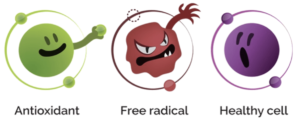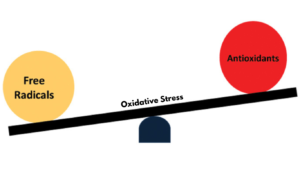In today’s world, we are constantly bombarded by a myriad of chemicals and toxins in the environmentsuch as pollutants, cleaning products, paints, chemicals from factories, cigarette smoke, UV radiation, pesticides, unhealthy&processed foods. Even though these things might not seem harmful at first, their collective impact on our health and aging process is intense and often underestimated.These harmful chemicals get into our bodies and cause trouble at the smallest level i.e. inside our cells. They create something called free radicals which trigger oxidative stress and inflammation and can lead to problems in breathing, heart disease, premature aging, neurological disorders, Alzheimer’s disease and even cancer.
Antioxidants generation as a normal phenomenon in the body
A free radical is like a naughty atom or molecule because it has an electron that doesn’t have a buddy to hang out with. It tries to find a buddy by stealing an electron from another atom or molecule nearby. This stealing process can cause damage to the other molecule which then, also becomes a free radical, and the cycle repeats. This cycle of stealing electrons can be very troublesome for the body.Though these troublemakers,in low and moderate amounts,serve some important functions in the body like the immune system uses the cell damaging property of free radicals to destroy harmful bacteria and viruses. Free radicals also act like little messengers inside the cells, telling them when to grow and when to die. They help pass along important messages between cells, like telling the blood vessels when to relax or brain cells to send signals.Exposure to chemicals and toxins in the environment can cause abnormally high levels of free radicals which affects the cell functioning by messing up with proteins, fats and DNA in cells causing aging and various diseases.
Antioxidants are like superheroes that catch the naughty free radicals and stop them from causing damage. Our bodies make some of these superheroes on their own and some we get from food. When antioxidants meet free radicals, they give them a hug, basically, by sharing their own energy. This stops them from causing more trouble, thus breaking the chain reaction. Then, the free radicals can’t hurt us anymore. Thus, antioxidants keep our cells healthy and protect against various diseases and aging process.

How to Prevent the Overgeneration of Free Radicals in the Body
When free radicals outweigh the antioxidant supply, the body gets into the condition of oxidative stress. So, using antioxidants from foods can be of help in protecting our bodies. For this a knowledge of their presence and amounts in different foods is essential.
A useful guide has been given below for suitable diet planning.

Antioxidant Content of some foods
Nuts & seeds
| Nuts and Seeds | Antioxidant content in mmol / 100 gm |
| Walnuts with pellicle (50 halves) | 21.9 |
| Sunflower seeds (¾ C) | 6.4 |
| Peanuts with pellicle (2/3 C) | 2.0 |
| Pistachio (200 shelled) | 1.7 |
All these nuts should be eaten with skin (pellicle) for maximum benefit.
Ways to add nuts and seeds to the diet
- Sprinkle chopped nuts or seeds on top of your oatmeal /yogurt /cereal / salad
- Snack on a combination of your favourite nuts and seeds and add some dried fruit for sweetness.
- Roast nuts and seeds with a pinch of salt or your favourite spices for a quick, crunchy snack.
- Incorporate peanuts into stir-fries and curries for a crunchy texture.
- Add chopped nuts to your baked goods, such as muffins, bread, or cookies.
Fruits
| Fruits | Antioxidant content in mmol / 100 gm |
| Prunes (10 in no.) | 2.4 |
| Strawberry (13 no.) | 2.1 |
| Pomegranate | 1.8 |
| Oranges (1 small) | 0.9 |
| Papaya | 0.6 |
| Apples (½ medium) | 0.4 |
Other fruits rich in antioxidants whose exact values have not been analysed include mango, cherry,lemon, musk melon, water melon, kiwi,guava, jamun, apricot, plums.
Berries – Black currant, blackberries, blueberries, goji berries and cranberries. Processing of berries to jam reduces its antioxidant content.
Dried Fruits
| Dried Fruits | Antioxidant content in mmol / 100 gm |
| Dried amla | 261.5 |
| Dried apples | 3.8 |
| Dried plums | 3.2 |
| Dried apricots | 3.1 |
| Dried mango | 1.7 |
| Dried dates | 1.7 |
Ways to add dried fruits to the diet
- Make a powder of dried amla. You can have one tsp of this with water after meal. This would help in digestion and improve iron absorption besides the antioxidant benefit.
- Add dried mango powder to green chutney.
- Add a handful of dried fruits to your oatmeal or porridge or salad
- Blend dried fruits into your morning smoothie for added sweetness and nutrients.
- Snack on a combination of your favourite nuts and seeds and add some dried fruit for sweetness.
- Make energy balls by blending dried fruits like dates with nuts, seeds, and a bit of honey or coconut oil.
- Add dried fruits to cookies, muffins, bread, or cakes.
Herbs &Spices
| Herbs & Spices | Antioxidant content in mmol / 100 gm |
| Clove, dried and ground | 277.3 |
| Dried mint leaves | 116.4 |
| Cinnamon, dried ground | 77 |
| Oregano, dried ground | 63.2 |
| Thyme, dried ground | 56.3 |
| Rosemary, dried ground | 44.8 |
| Sage, dried ground | 44.3 |
| Dried bay leaf | 27.8 |
| Nutmeg, dried ground | 26.4 |
| Ginger dried | 20.3 |
| Dried basil | 19.9 |
| Saffron, dried whole stigma | 17.5 |
Dark chocolate – dark chocolate with 70-99 % cocoa has 10.9 mmol / 100 gm. Theantioxidant content of chocolate decreases with reduction in cocoa content.
Cereals
| Cereals | Antioxidant content in mmol / 100 gm |
| Buckwheat whole meal flour (kuttu) | 2.0 |
| Pearl barley flour (jau) | 1.0 |
| Millet | 1.3 |
Beverages
| Beverages | Antioxidant content in mmol / 100 gm |
| Red wine | 2.5 |
| Pomegranate juice | 2.1 |
| Green tea, prepared | 1.5 |
| Grape juice | 1.2 |
| Prune juice | 1.0 |
| Black tea, prepared | 1.0 |
| Cranberry juice | 0.92 |
| Orange juice | 0.64 |
| Tomato juice | 0.48 |
| Cocoa with milk | 0.37 |
| Apple juice | 0.27 |
Vegetables – Black and green olives, broccoli, kale, cabbage, cauliflower, red and green chili, carrot, mustard greens, spinach, coriander leaves, amaranth (chulai), colocasia leaves, drumstick leaves, avocado, sweet potato, bell peppers, pumpkin, karela, red cabbage, red beets, onion, tomato, garlic. Steamed carrots have higher antioxidants than raw carrots.
Steaming is the best method to retain the antioxidants in all vegetables as compared to boiling, frying, and microwaving. Slow cooking of vegetables like spinach, corn and tomato helps to break down the cell wall and release powerful antioxidants.
Sauces – Tomato based sauces, basil pesto, mustard paste, sun dried tomatoes and tomato puree.Tomato peel has the highest antioxidant content and should not be discarded while cooking.
Indian medicinal plants/ Ayurvedic herbs– Triphala, Arjuna, Aloe vera, shatavari, neem, brahmi, curry leaves, kala jeera, tulsi, ratanjyot, ashwagandha.Triphala, additionally acts as detoxifier, immune modulator and prevents cancer. 1 gm triphla can be taken with honey thrice a day.
Case Study
Dr X having cancer of the gums was prescribed immunomodulators. Immunomodulators are generally given during cancer treatment to help regulate and enhance the body’s immune response against cancer cells. Due to certain adverse side effects of the immunomodulators, the doctor advised to stop these and include antioxidant rich foods in the diet.
Antioxidant rich foods advised were easy to incorporate in the daily diet and made remarkable improvement in the patient. Antioxidant rich food acted more than a medicine.
A person requiring 1400 Kcal should include the following quantities from each food group.
Cereals & Millets (Rice, wheat, millets & other cereals) – 130 gm
Pulses (Lentil, green gram, chickpea, rajma, cowpea etc) – 60 gm
GLV – 100 gm
Other veg – 200 gm
Roots and tubers (Potato, arbi, sweet potato, yam)– 100 gm
Fruits – 200 gm
Seeds & nuts – 30 gm
Milk & curd – 300 ml
Fats & oil – 20 gm
To combat the effect of free radicals, choose a variety of foods rich in antioxidants in the diet on different days to get maximal benefit.
Are Antioxidant Supplements Beneficial
Large-scale observational studies, which track people’s eating habits and supplement use alongside their disease patterns, have found benefits from antioxidant-rich diets, especially the ones having a variety of colourful vegetables and fruits. However, randomized controlled trials of antioxidant supplements have not supported many of these benefits.This is because foods rich in antioxidants usually contain a combination of vitamins, minerals, fibre, and phytochemicals which work together to provide health benefits beyond what individual supplements can offer. The antioxidants in food are also more readily absorbed by the body compared to those in supplements. In fact, excessive intake of these supplements can be harmful. It is better to obtain antioxidants from a well-balanced diet.
By harnessing the power of antioxidants, we can navigate the challenges posed by the environment,protect our cells from damage, reduce the risk of chronic diseases, support our immune system, and enjoy the benefits of healthy aging. So next time you sit down for a meal, remember to fill your plate with colourful, nutrient& antioxidant dense foods that nourish both your body and soul.



